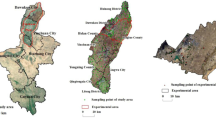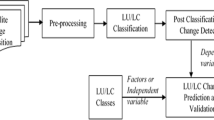Abstract
The upper Huanghe(Yellow) River basin is situated in the northeast of the Qinghai-Xizang(Tibet)Plateau of China. The melt-water from the snow-cover is main water supply for the rivers in the region during springtime and other arid regions of the northwestern China, and the hydrological conditions of the rivers are directly controlled by the snowmelt water in spring. So snowmelt runoff forecast has importance for hydropower, flood prevention and water resources utilization. The application of remote sensing and Geographic Information System (GIS) techniques in snow cover monitoring and snowmelt runoff calculation in the upper Huanghe River basin are introduced amply in this paper. The key parameter—snow cover area can be computed by satellite images from multi-platform, multi-temporal and multi-spectral. A cluster of snow-cover data can be yielded by means of the classification filter method. Meanwhile GIS will provide relevant information for obtaining the parameters and also for zoning. According to the typical samples extracting snow covered mountainous region, the snowmelt runoff calculation models in the upper Huanghe River basin are presented and they are mentioned in detail also. The runoff snowmelt models based on the snow-cover data from NOAA images and observation data of runoff, precipitation and air temperature have been satisfactorily used for predicting the inflow to the Longyangxia Reservoir, which is located at lower end of snow cover region and is one of the largest reservoirs on the upper Huanghe River, during late March to early June. The result shows that remote sensing techniques combined with the ground meteorological and hydrological observation is of great potential in snowmelt runoff orecasting for a large river basin. With the development of remote sensing technique and the progress of the interpretation method, the forecast accuracy of snowmelt runoff will be improved in the near future. Large scale extent and few stations are two objective reality situations in China, so they should be considered in simulation and forecast. Apart from dividing, the derivation of snow cover area from satellite images would decide the results of calculating runoff. Field investigation for selection of the learning samples of different snow patterns is basis for the classification.
Similar content being viewed by others
References
BAUMGARTNER M F, RANGO A, 1995. A microcomputer-based alpine snow-cover analysis system[J]. PEER-Reviewed Article, 36(2): 1475–1486.
CAZORZI F and FONTANA G Dalla, 1996. Snowmelt modeling by combining air temperature and distributed radiation index [J]. Journal of Environmental Hazards, 32(4): 161–171.
DENG Ju-long, 1986. Grey Prediction and Decision[M]. Wuhan: Industry University of Central China Press, 103–117. (in Chinese)
LAN Yong-chao, 1991. Period analysis and stepwise regression double riddling model based on satellite snow cover data for forecasting snowmelt runoff [J]. Journal of Remote Sensing Technique and Its Application, (Special Issue): 113–117. (in Chinese)
LAN Yong-chao, 1993. Application of grey cognate degree analysis in snowmelt runoff forecasting[J]. Journal of Glaciology and Geocryology, 15(3): 481–486. (in Chinese)
LAN Yong-chao, KANG Er-si, 1997. Grey Topology Forecast Method about runoff in the upper Yellow River[J]. Journal of Glaciology and Geocryology, 19(4): 308–311. (in Chinese)
LAN Yong-chao, KANG Er-si, 1998. Runoff forecast model for during spring inflow to the Longyangxia Reservoir in the upper Yellow River Basin[J]. Journal of Glaciology and Geocryology, 20(4): 199–205. (in Chinese)
LAN Yong-chao, 2000. Trend and characteristic of variation on the runoff the upper Yellow River above Tangnag[J]. Journal of Desert Research, 20(3): 273–277.
LI Pei-ji, 1987. Seasonal snow resources and their fluctuations in China[A]. IAHS Pub. [C], (166): 93–104.
LI Pei-ji, 1989. Recent treats and regional differentiation of snow variation in China[A]. IAHS Pub. [C], (183): 3–9.
MARTINEC J, RANGO A, 1987. Interpretation and utilization of areal snow cover data from satellites[J]. Annals of Glaciology, 42(3): 166–169.
RANGO A, MARTINEC J, 1995. Degree-day method for snowmelt computation[J]. Water Resources Bulletin, 31(4): 657–669.
WANG Jian, 1988. Snow cover distribution in the Heihe Basin in the Qilian Mt. [A]. Memoirs of Lanzhou Institute of Glaciology and Geocryology, Chinese Academy of Sciences[C]. (6): 55–63. (in Chinese)
YANG Ke-fei, MA Fu-hong, 1984. Discussion on the long-term forecast and management of runoff in April–June along the upper Yellow River[J]. Journal of Hydropower, 1(1): 130–134. (in Chinese)
ZHANG Shun-ying, 1988. Forecasting snowmelt runoff using NOAA/TIROS satellite data for the Huanghe River and Heihe River[A]. Memoirs of Lanzhou Institute of Glaciology and Geocryology, Chinese Academy of Science[C], (6): 75–79. (in Chinese)
Author information
Authors and Affiliations
Additional information
Foundation item: Under the auspices of the Knowledge Innovation Project of Cold and Arid Regions Environmental and Engineering Research Institute of the Chinese Academy of Sciences (No. 210100.210016), the Knowledge Innovation Project of the Chinese Academy of Sciences(No. KZCX1-10-03) and the National Natural Science Foundation of China (No. 49731030).
Biography: LAN Yong-chao (1957 –), male, a native of Lanzhou City, associate professor. His research interests include water resources and hydrology in northwest region of China.
Rights and permissions
About this article
Cite this article
Lan, Yc., Wang, J., Kang, Es. et al. Snow cover monitoring by remote sensing and snowmelt runoff calculation in the upper Huanghe River basin. Chin. Geograph.Sc. 12, 120–125 (2002). https://doi.org/10.1007/s11769-002-0019-7
Received:
Issue Date:
DOI: https://doi.org/10.1007/s11769-002-0019-7




